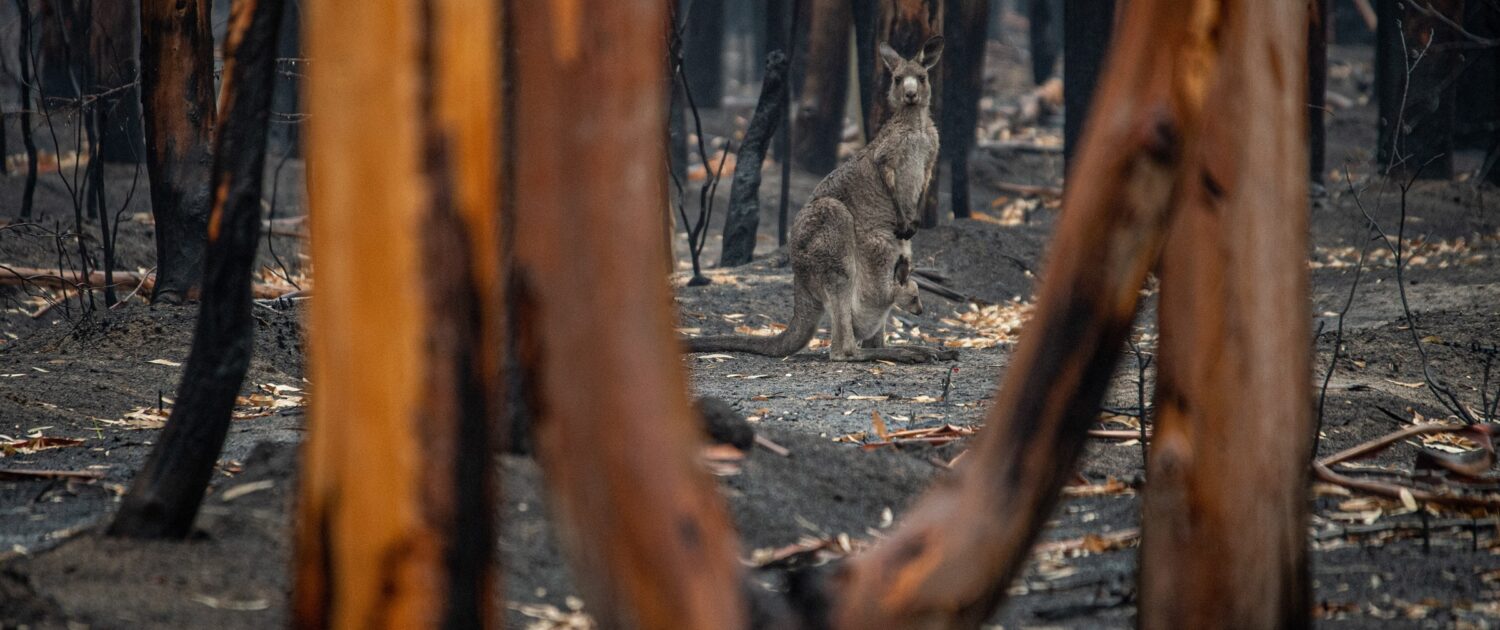March 31, 2022

Bushfires and grassfires are common headlines on today’s news. Grassfires are medium intensity but fast-moving events, lasting usually from five to ten seconds and smoldering within minutes, whereas bushfires are slower moving, with a higher intensity. They may last longer (from two to five minutes) but they can smolder for days. Both fire types are considered part of Australia’s natural environment and Australian natural ecosystems have evolved with them so much that many of their native plants became highly combustible and fire prone.
According to Tim Flannery, a researcher at the University of Melbourne, fire is the most important ecological force at work in the Australian environment: some native plant species have evolved a variety of mechanisms to survive fires and others require bushfires to regenerate. For example, plants with epicormic shoots or lignotubers sprout after a fire, and plants with fire-triggered seeds or oil-containing leaves, like the eucalyptus, encourage fires [1].
Aboriginal people used to set fires to facilitate hunting and produce lusher leaves which would be used to fatten kangaroos. This may be the reason why James Cook called Australia “This continent of smoke”. When European settlers moved to Australia, population growth and urban sprawling in bushlands increased the risk of bushfires, as proven by the “Black Sunday” episode of 1925-1926. Over a two-month period, 60 people were killed in Walbourton, near Melbourne. Similarly, the “Black Tuesday” episode of 1967 killed 62 people in Tasmania. Nowadays, fires have not gone extinct but have actually exacerbated due to the climate crisis effects. The September 2019 – March 2020 bushfires season was indeed the worst fire season of Australia’s history.
The basic factors that determine whether a bushfire will occur are the presence of fuel, oxygen and the source of ignition. The fire intensity and speed at which a bushfire spreads depends on the ambient temperature, the fuel load, fuel moisture, wind speed and the slope angle. Fuel load refers to the amount of vegetation in the landscape and their quality (twigs, leaf litter and branches burn quickly). Dry fuel burns quickly so the time passed since the last rainfall is taken as significant weather indicator for bushfire ocurrence prediction. Other considerable factors are also related to weather: strong winds promote the rapid spread of fires by lifting burning embers into the air. Among all this, the climate crisis does not help.
The Australian climate has warmed by more than one degree Celsius in the past century: heatwaves and droughts have dried out the underground and created conditions that increased the risk of bushfires [2]. Stakes are high: in 2020, an international team of scientists discovered that the probability of another 2019-2020 bushfires crisis could increase by eight times if global air temperature warmed by 2 °C. Furthermore, bushfires themselves contribute to the climate crisis. It is believed that the 2019-2020 bushfires have released approximately 350 million tons of carbon dioxide. David Bowman, professor of Pyrogeography and Fire science at the University of Tasmania, warned that Australian forests have been so damaged that they may need more than 100 years to re-absorb the carbon that has been released so far [3].

Fig. 1: A kangaroo and her joey who survived the forest fires in Mallacoota, Australia. Photo by Jo-Anne McArthur (September 2020).
The impact of bushfires on the wildlife is massive as they kill animals and destroy their habitats, leaving the survivors more vulnerable. Professor Chris Dickman of the University of Sydney declared that during the 2019-2020 bushfires, over 800 million animals died in New South Wales and more than one billion nationally [4]. He carries one saying that Australia has the highest species loss rate of any other region in the world. Koalas are perhaps the most vulnerable species because they are slow-moving and thrive in the eucalyptus trees – which are highly flammable. But many other mammals, birds and reptiles are also endangered both directly and indirectly – meaning that their habitats are destroyed. Wombats and snakes are the most fire resilient animals because they can burrow underground.
The impact on human beings is also devastating. Bushfires have killed over 800 people since 1851, and left many without vital resources (e.g., water and food) or for years traumatized by the casualties and the loss of homes and livestock. After the 2016 Yarloop Fire in Western Australia, which destroyed the town, some facilities, many households and infrastructure, local citizens still suffered from psychological distress two years after the event. David Bowman of the Fire Center Research Hub at the University of Tasmania states that “a third of the Australian population has been impacted, with prolonged, episodic exposure and sometimes extreme health impacts” by the 2019-2020 bushfires. Finally, bushfires can also produce particulate matter pollution and airborne particles that are small enough to enter and severely damage human lung tissues.
The economic impact of bushfires is also huge. Based on Moody’s analyses, the 2019-2020 Australian bushfires have caused an economic loss of more than A$ 4.5 billion (equivalent to approximately 3.4 billion USD), crippled consumers’ confidence and harmed the farming and tourism sectors.
In January 2020, Prime Minister Scott Morrison raised the prospect of establishing a royal commission to work on the issue, introduced a Fire Danger Rating System (“FDR”) for a better nationwide bushfires and grassfires management. This new system has confirmed to be beneficial to the national management but a lot of work still needs to be done.
Figure 1 and preview image: A kangaroo and her joey who survived the forest fires in Mallacoota, Australia (September 2020). Free-source photo by Jo-Anne McArthur on Unsplash.
Cover photo: Bushfires below Stacks Bluff, Tasmania, Australia (Januray 2021). Free-source photo by Matt Palmer on Unsplash.
Bibliography:
[1] Flannery, T. (2002). The future eaters: An ecological history of the Australasian lands and people. Grove Press.
[2] Nerilie, A. (2019, December 31). Australia’s Angry Summer: This Is What Climate Change Looks Like. Scientific American Blog Network. https://blogs.scientificamerican.com/observations/australias-angry-summer-this-is-what-climate-change-looks-like/.
[3] Foley, M. (2020, January 2). Bushfires spew two-thirds of national carbon emissions in one season. The Sydney Morning Herald. https://www.smh.com.au/politics/federal/bushfires-spew-two-thirds-of-national-carbon-emissions-in-one-season-20200102-p53oez.html.
[4] The University of Sydney. (2020, January 3). A statement about the 480 million animals killed in NSW bushfires since September. The University of Sydney. https://www.sydney.edu.au/news-opinion/news/2020/01/03/a-statement-about-the-480-million-animals-killed-in-nsw-bushfire.html.


